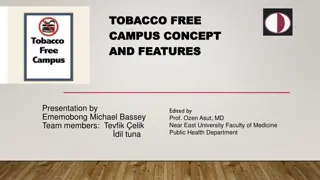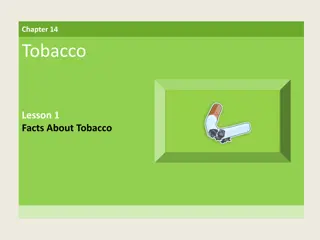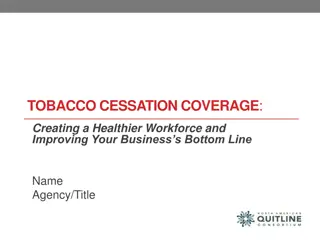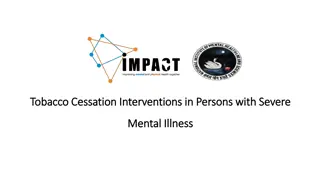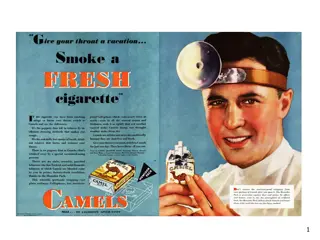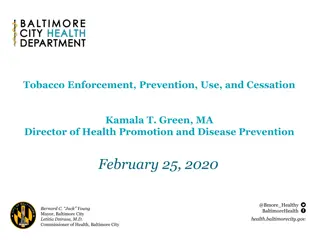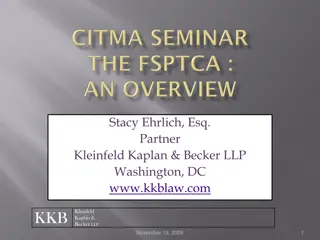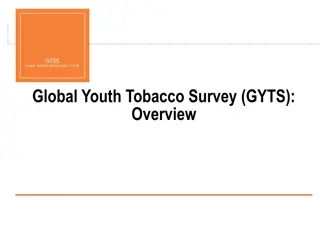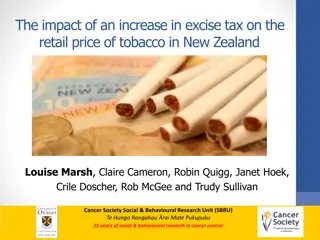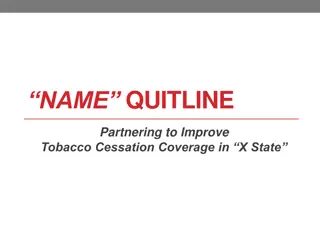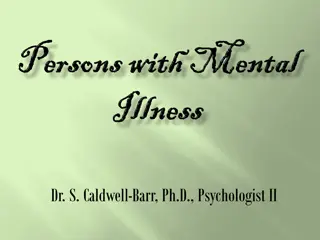Understanding the Impact of Tobacco Use on People with Serious Mental Illness
People with serious mental illness are significantly affected by tobacco use, with smoking being a leading preventable cause of early death in this population. This presentation highlights the reasons behind smoking in individuals with mental illness, challenges faced in cessation efforts, and the importance of integrated treatment models for better outcomes.
Download Presentation

Please find below an Image/Link to download the presentation.
The content on the website is provided AS IS for your information and personal use only. It may not be sold, licensed, or shared on other websites without obtaining consent from the author. Download presentation by click this link. If you encounter any issues during the download, it is possible that the publisher has removed the file from their server.
E N D
Presentation Transcript
Tobacco & SMI: Bending the Deadly Curve Gregory A. Miller, M.D. Mary Barber, M.D. Maxine Smalling, R.N. New York State Statewide Grand Rounds January 21, 2015
2 Financial Disclosures All of the faculty and planners associated with this CME activity have indicated they have no financial arrangements or affiliations with any commercial entities whose products, research or services may be discussed in these materials. Any discussion of investigational or unlabeled uses of a product will be identified.
3 What We Know People with serious mental illness die, on average, 25 years younger than the general population Almost of cigarettes are smoked by SMI and/or SUD Smoking is the leading preventable cause of early death: Studies have attributed > of early death in SMI to smoking related illnesses Prevalence in people with SMI who smoke is not changing.
4 What We Know Persons with mental illnesses and substance abuse disorders use tobacco for the same reasons as the general population: as part of a daily routine to relieve stress and anxiety. However, genetic linkages and neurobiological abnormalities are one of many factors explaining heavy levels of smoking in people with mental illness. For people with mental illness, nicotine might normalize associated deficits in sensory processing, attention, cognition and mood.
5 What We Know People with SMI can quit and want to quit Evidence suggests integrated co-occurring model has better outcomes May need more intensive treatment Longer duration of counseling and medication Higher dosing/ combination therapy Relapse management and prevention Attention to opportunities in treatment cycle
6 What We Know Psychiatric clinicians have responded slower than other health professionals Cigarettes as behavioral reinforcement Belief that smoking reduction/cessation is not a realistic goal Patients only pleasure & least of their worries Contributes to normalizing
7 A New Normal Changing the Culture of Tobacco for people with SMI Society has become less tolerant of tobacco use Directly related to rapid decrease in prevalence of smoking Showing in adolescent population as well Health disparity populations less impacted by public inhibitions Tobacco Free treatment settings Consistent with Recovery Consistent with wellness self management State psychiatric hospitals across the country
8 Preparing for Change Definition of Tobacco-Free Campus Wide Facility Clean Indoor Act and smoke free facilities vs. tobacco-free campus- no designated smoking area on campus Emphasis on tobacco-free as opposed to smoke free Assessing status of tobacco-free facilities per policy 10 of 24 facilities classified as Early Adopters 4 of 10 did not meet definition of tobacco-free campus wide Planning for the Change Identification of facility champions Formation of Facility Change Committees
9 Four Pillars of Organizational Change Policy Change Communication Staff Support Patient Support
10 Policy Change Implementation Campus Wide Tobacco-Free Facility Policy Assess changes needed Plan for the change with timelines Implementation of the change process Conduct ongoing evaluation
11 Communication Provide consistent message and signage Health and wellness of patients, staff and visitors Supportive Non-punitive Signage, posters and pamphlets
12 Staff Support Provide critical resources to maximize readiness and competence Strong collaboration with Unions as key partners Provide Nicorette gum or lozenge during working hours for 2 months Facilitate ongoing support from regional partners- ESCAPE in NYCProvide advanced training on smoking cessation treatment-FIT Modules.



